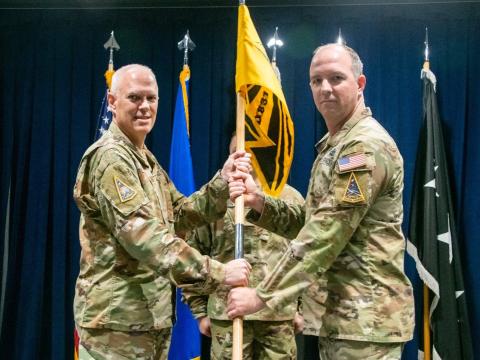Experimentation Task Force Improves Long-Range Defense Comms
The Defense Operations Grid-Mesh Accelerator (DOGMA) will utilize artificial intelligence (AI) technologies and satellites to strengthen and upgrade the long-range radar systems that warfighters use today to support U.S. air defense systems, according to General Dynamics Information Technology (GDIT) officials. These technological improvements, made by crews with GDIT and Amazon Web Services, will address several obstacles that currently exist when it comes to connectivity and communication capabilities, such as rough terrain.
GDIT, Amazon Web Services and military officials completed a major milestone in August when they successfully displayed DOGMA’s capabilities at the 2024 Technology Readiness Experimentation Exercise (T-REX 24-2), according to GDIT personnel. At the event at Camp Atterbury, Indiana, crews showcased DOGMA’s potential and proved that the initiative is a five or six on the technology readiness level scale, according to Brandon Bean, artificial intelligence (AI)/machine learning (ML) director, GDIT’s Defense Division. Reaching these two levels means the tool was validated and demonstrated in a relevant environment, according to the Department of Defense Technology Readiness Levels. Despite this success, officials close to the initiative, including Bean, said that further technological and logistical steps are necessary to ensure that the system is fully mature and ready to be used by warfighters across the military.
Project leaders want to see DOGMA included in the current operating systems more frequently, according to Lt. Col. Matthew Limeberry, commander, Rapid Defense Experimentation Reserve Task Force, Office of the Under Secretary of Defense for Research and Engineering. The increase in usage would expose the DOGMA system to enormous amounts of additional data, which would lead to several improvements.
“The inclusion and data transparency that [DOGMA offers] will allow faster predictive analysis,” Limeberry said in an interview with SIGNAL Media. “As we get larger data sets and models, refining processing speeds with DOGMA and Amazon Web Services on the back end, how quickly can we push information to senior leaders or decision-makers, and the data transmitted is trusted data from the AI and machine learning processing from DOGMA.”
“That allows us to make faster and more satisfactory decision-making,” Limeberry added. “If we had to defend our airspace or defend an allied partner’s airspace, this is a more trusted, valuable asset to have integrated into our networks of command and control.”
The next challenges crews working on the DOGMA tool must overcome are obtaining service sponsorship and demonstrating its ability in live environment training situations, according to Bean. Once they achieve these milestones, officials can rank the initiative in the eight and nine categories on the technology readiness levels scale, which are the highest two levels. At this point, the DOGMA initiative would be ready for full production; however, since this is a lengthy process, they are still more than half a year out, according to Bean and Limeberry. Despite this long road ahead, certain military branches are beginning to take advantage of the system right now, even in its initial stages.
“Although it’s not a program of record, as we call it—it’s not a future, budgeted and planned-for program like vehicles or large platforms—it is being utilized by services and combatant commands, even though it’s [in the] prototyping phase to enhance that decision-making, and it’s on the glide path for transition to become a true program,” Limeberry said.
As briefly mentioned, the DOGMA system is a new initiative that is making long-range defense communications more reliable and up to date. The tool is accomplishing this by “enhancing security, data processing and decision-making speed,” according to GDIT officials, and it has already helped soldiers in a plethora of ways. Firstly, its integrated AI technologies can alert officials of possible threats before they occur, leading to a faster and more effective response. In addition to identifying threats, the DOGMA system can also provide warfighters with safe and secure connectivity, even in areas where soldiers traditionally have had trouble maintaining communication. Furthermore, the tool’s versatility allows it to adjust depending on which defense situation warfighters are engaged in during battle. These benefits, among several others, have been observed and recorded by GDIT officials.
One specific use case that DOGMA has proven to accomplish is the ability to significantly speed up the process of identifying and memorizing tactics, techniques and procedures of aircraft, including unmanned aerial vehicles. Before the application of DOGMA, this was a manual process that could take up to 30 minutes to complete. Now, by using DOGMA, crews can accomplish the same task in just three seconds; however, Bean said there is still room for improvement.
“In the future, we plan to get that down to milliseconds by adding additional capabilities, such as generative AI, additional speech-to-text,” Bean said in an interview with SIGNAL Media. “And the whole point there is really to reduce the fatigue or the workload on the operator.”

Looking to the future, crews are striving to apply the DOGMA initiative to additional use cases. Most notably, the project could help officials replace older communication systems with newer, improved ones.
Furthermore, they are looking to apply this project to bases across the world to create a more connected and unified communication network, a goal that fostered this innovation.
The entire project came to light when Army personnel stationed at Joint Base Elmendorf-Richardson in Alaska began reporting communication and connectivity troubles. They needed a way to more reliably retrieve data stored onto sensors, which has been difficult to accomplish due to the base’s remote environment and extreme terrain in Alaska. The DOGMA initiative is projected to help officials battling these challenges in several ways, Bean explained.
“So, DOGMA was a natural transition to current state architecture,” Bean said. “And so, as we looked to develop this, we partnered with Amazon Web Services, and they created one half of the capability, which we call Cloud Edge Global Access, but that’s the secure cloud backbone communications path, and then GDIT came in with the other side of that, which is the AI/machine learning to actually take those radar signatures and turn those into forward-looking predictions of where aircraft will be over space and time.
“So, the end result of this was to create a communication-constrained capability that would allow real-time, or near real-time, tracking of these aircraft with greater fidelity and less risk, to not only the Alaska command but to the entire air defense picture,” Bean added.





Comments